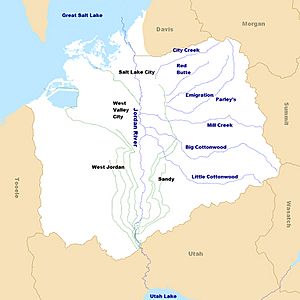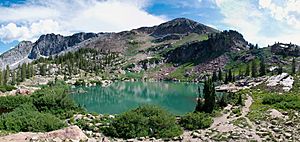Little Cottonwood Creek (Salt Lake County, Utah) facts for kids
Quick facts for kids Little Cottonwood Creek |
|
|---|---|

The Little Cottonwood Creek in Murray City Park, Murray, Utah
|
|

Little Cottonwood Creek and other Salt Lake County streams
|
|
| Country | United States |
| State | Utah |
| Physical characteristics | |
| Main source | Cecret Lake, Alta, Utah, Salt Lake County, Utah 11,500 ft (3,500 m) 40°34′12″N 111°37′19.2″W / 40.57000°N 111.622000°W |
| River mouth | Jordan River Murray, Utah, Salt Lake County, Utah 4,490 ft (1,370 m) 40°39′57″N 111°54′27″W / 40.66583°N 111.90750°W |
| Length | 27.72 mi (44.61 km) |
| Basin features | |
| Basin size | 46 sq mi (120 km2) |
Little Cottonwood Creek is an important stream in Utah, United States. It starts high up in the Wasatch Mountains near the ski town of Alta. The creek then flows west through Little Cottonwood Canyon.
After leaving the canyon, it enters Salt Lake Valley. It continues its journey through cities like Sandy, Midvale, and Murray, Utah. Finally, it flows into the Jordan River south of Salt Lake City. The creek is almost 27 miles (43 km) long.
The very beginning of Little Cottonwood Creek is in Cecret Lake. This small lake is located near Alta. The entire area that drains into Little Cottonwood Creek is about 46 square miles (120 km2). The elevation in this area ranges from about 4,490 to 11,500 feet (1,370 to 3,510 m).
Contents
History and Human Impact on the Creek
People started building communities around Little Cottonwood Creek soon after pioneers arrived in Salt Lake Valley in 1847. These early settlements used the creek's water for farming.
Mining and Settlement Growth
In the 1870s, valuable metals like gold, silver, copper, and lead were found in nearby canyons. This discovery brought many new people to the area. They came to work in the mines and process the ore.
Over time, especially from the mid-1900s, farming land near the creek was replaced by homes. This happened as the population of Salt Lake Valley grew.
Protecting Our Drinking Water
The part of the creek upstream from Little Cottonwood Canyon is mostly covered by forests and rangeland. This area is very important because it's protected as a source of drinking water. Many people also enjoy outdoor activities here.
The lower part of the creek, from the canyon mouth to the Jordan River, flows through urban areas. The creek also helps generate electricity for Murray City.

Mining's Lasting Effects
The first official mining started in Little Cottonwood Canyon in 1865. The mines mainly produced silver and lead, along with some copper, gold, and zinc. These metals were found in rocks like shale, limestone, and dolomite.
During the 1870s, mining was very active, and many valuable deposits were found. Several smelters, which are factories that melt ore to get metals, operated along the creek. These smelters created waste products like arsenic and slag.
Even today, past mining and smelting activities affect the creek's water. Waste materials from mines and smelters can release tiny amounts of metals into the stream. These metals can be stirred up and dissolved in the water. Today, a major concern for the creek's living things is pesticides from water runoff from homes.
How Water Flows in Little Cottonwood Creek
The way water flows in the urban parts of Little Cottonwood Creek is quite complex. This is because of the many canals and structures that move water for different users. The water in the urban creek comes from various sources throughout the year.
These sources include melting snow, storm water, ground water, and water that returns from irrigation. Water is also brought in from the Jordan River. Each of these sources affects the water quality differently depending on the season and how much water is flowing. About 85 percent of the water that flows out of Little Cottonwood Canyon comes from melting snow.
The water flow in Little Cottonwood Creek is similar to many other urban streams along the Wasatch Front. A system of diversions to take water for irrigation began soon after settlers arrived in Salt Lake Valley in 1847.
As more people moved to the Wasatch Front, more water was needed for drinking and home use. To meet these needs, water is taken from several streams, including Little Cottonwood Creek, as they leave the canyons. Farmers downstream then get their water from the Jordan River, which is moved across the valley through a system of canals. Some of this Jordan River water is even added to the urban section of Little Cottonwood Creek.
The creek is considered to be at flood stage when the water level reaches 5.7 feet (1.7 m). Major floods are rare. However, there was significant flooding in 1983 and again in the summer of 2010. During the 2010 flood, the water level was 6.3 feet (1.9 m) above the creek banks.
Animals Living in the Creek
The Utah Division of Wildlife Resources helps keep the creek healthy by adding 1,000 trout each year. These trout are mainly rainbow and Bonneville cutthroat trout. Because the higher parts of the creek are still affected by old mining operations, not many of the stocked fish survive from one year to the next.


